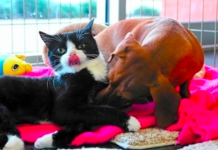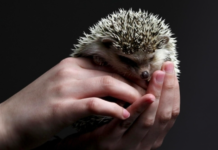Last Updated on January 24, 2024 by Fumipets
Exploring the Enigmatic World of Red-Eyed Crocodile Skinks
In the realm of reptiles, the Red-Eyed Crocodile Skink stands out as a fascinating and mysterious creature. Native to the rainforests of New Guinea, these unique reptiles, scientifically known as Tribolonotus gracilis, have captured the attention of exotic pet enthusiasts and reptile aficionados alike. With their striking appearance, characterized by vibrant red eyes and scaly, prehistoric features, the Red-Eyed Crocodile Skinks have become a captivating subject of interest.
Let’s embark on a journey to uncover the secrets of these elusive creatures and delve into their distinctive characteristics.
Red-Eyed Crocodile Skinks
Papua New Guinea and the Solomen Islands are home to the timid red eyed crocodile skinks. They thrive in glass terrariums with regulated humidity and temperature settings when kept in captivity. Domestic skinks often emerge throughout the day, despite being crepuscular in the wild. They are averse to handling but add beauty to display terrariums since they get along well with frogs, geckos, and other tiny lizards that have similar environmental needs.
Red-Eyed Crocodile Skink Breeders in the USA
Finding a reliable Red Eyed Crocodile Skink breeder requires time and effort. They can assist you to learn how to take care of your skink and any particular requirements they may have.
We’ve compiled a list of a few Red Eyed Crocodile Skink breeders to get you started.
Red Eyed Crocodile Skink Breeders Near Me

Breedir.org provides a comprehensive list of breeders located throughout North America, with locations all across the USA.
Red-Eyed Crocodile Skink Breeders That Ship

Check out Snakes At Sunset to have your Red-Eyed Crocodile Skink shipped directly to your door.
Red-Eyed Crocodile Skink Rescue

Fresh Start Rescue offers a number of adoptable reptiles, including Red-Eyed Crocodile Skinks.
What is the Price of a Red-Eyed Crocodile Skink?
Depending on the breeder, Red-Eyed Crocodile Skinks may cost anywhere from $130 and $280. Despite their rising popularity, virtually little is known about them since they have only been sold domestically since the 1990s.
The legal status of these creatures varies according to the nation they are from, with some, like New Guinea, forbidding the export of these skinks while many others do. As a result, there is a high likelihood that Red-Eyed Crocodile Skinks will be traded illegally as pets. The majority of reptiles marketed in the US are wild-caught rather than captive-bred.
Questions to Ask a Red-Eyed Crocodile Skinks Breeder
The first thing you should ask your preferred breeder is where the skink was got from since Red-Eyed Crocodile Skinks are susceptible to being used in illicit pet trade. If the skink you’re going to purchase was taken in the wild, it’s crucial to know where, in which nation, and how it was brought into the US. Only Red-Eyed Crocodile Skinks that have been lawfully imported or that have been captive-bred domestically should be sold by reputable breeders.
Make sure the skink you are buying is in good condition. Skinks without tails are susceptible to bacterial infections while their tails are growing again. You may get a fair sense of the lizard’s health by looking at the tank conditions of your possible pet. Red-Eyed Crocodile Skinks are susceptible to bacterial illnesses in tanks that are not cleaned well or regularly enough.

Things to look for when purchasing a Red-Eyed Crocodile Skink:
• Check for external parasites, injuries, or malformations.
• Search for bright, gleaming, and attentive eyes. Dehydration or sickness are symptoms of dull eyes.
• Evaluate the animal’s general temperament. They need to be on guard. If touched, they should make an effort to get away, make noise, or seem to be dead.
Specific questions for breeders include:
• From where did the skink come?
• How long after arriving in the US were they quarantined?
• Were they inspected by a veterinarian or was a fecal sample tested? – You may find out whether the skink has parasitic worms or other dangerous microorganisms by looking at its feces and doing tests.
Five Things to Know Before Buying a Red-Eyed Crocodile Skink
1. They lose their tails when they become scared.
Red-Eyed Crocodile Skinks turn over and pretend to be dead when disturbed. As an added layer of protection, they also droop their tails. This usually happens as a result of owners touching things excessively.
2. They live a long time.
In captivity, Red-Eyed Crocodile Skinks have an average lifespan of 10 to 12 years.
3. They need calcium supplementation.
When housed in captivity, Red-Eyed Crocodile Skinks are susceptible to calcium shortages, much like many other lizard species. This implies that in order to maintain their health, they need be given a calcium supplement every other day.
Lack of calcium and vitamin D3 in the food puts skinks at a greater risk of getting the potentially deadly metabolic bone disease.

4. They are crepuscular.
In the wild, Red-Eyed Crocodile Skinks are crepuscular, which means that dusk is when they are most active. Make sure your skink gets 12 hours of “daylight” and 12 hours of “darkness” in their terrarium in order to establish a natural cycle.
5. They should not be kept in pairs.
Red-Eyed Crocodile Skinks are wonderful additions to terrariums that also include frogs, geckos, and other lizard species; however, there should only be one of these skinks in the tank. It is quite challenging to breed them in captivity since they become violent when maintained in groups of two or more.
https://www.youtube.com/watch?v=LEfZZFP3-CE
Conclusion
Display terrariums look stunning with Red-Eyed Crocodile Skinks. Although they dislike being touched, they may get along well with many other species. We hope that our breeder directory will enable you to locate a trustworthy skink breeder from whom to purchase your reptile. It’s crucial to conduct your research and understand where your skink came from since Red-Eyed Crocodile Skinks are prone to being used in illicit pet trades.
Questions and Answers about Red-Eyed Crocodile Skinks:
What sets Red-Eyed Crocodile Skinks apart from other reptiles?
Red-Eyed Crocodile Skinks are distinguished by their unique appearance, featuring red or orange eyes, dark, armor-like scales, and a robust body structure. Unlike traditional skinks, their limbs are well-developed, resembling miniature crocodile limbs, adding to their distinctive charm.
What is the natural habitat of Red-Eyed Crocodile Skinks?
Indigenous to the rainforests of New Guinea, these skinks thrive in the humid and warm environment of tropical forests. They are often found near bodies of water, seeking refuge in the leaf litter and vegetation of the forest floor.
How do Red-Eyed Crocodile Skinks behave in captivity?
Red-Eyed Crocodile Skinks are known for their secretive and nocturnal nature. In captivity, they require environments that mimic their natural habitat, including high humidity levels and hiding spots. While they may be shy initially, with proper care and a suitable enclosure, they can become fascinating and interactive pets.
What is their diet like, and how do they hunt?
Red-Eyed Crocodile Skinks primarily feed on small invertebrates, such as insects and worms. They are ambush predators, relying on their keen sense of smell and stealth to capture prey. Their unique hunting behavior adds an element of intrigue to their care in captivity.
Are Red-Eyed Crocodile Skinks suitable as pets for beginners?
While these skinks are captivating, they are not recommended for beginners. Their specific habitat and dietary requirements, coupled with their secretive nature, demand a more experienced reptile owner. Adequate research and commitment are essential to provide these enchanting creatures with the care they deserve.


















